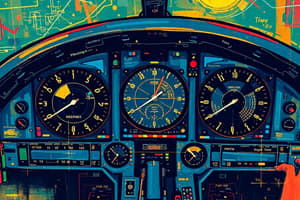Podcast
Questions and Answers
What does the altimeter provide?
What does the altimeter provide?
- A graphical representation of the aircraft's position
- A digital readout of the aircraft's altitude above mean sea level (MSL) (correct)
- Traffic information
- Weather radar information
What is usually indicated by the Vertical Speed Indicator (VSI)?
What is usually indicated by the Vertical Speed Indicator (VSI)?
- Engine performance parameters
- Climb or descent rate (correct)
- Terrain elevations
- Heading and course information
What is displayed on a horizontal situation indicator (HSI) or electronic compass?
What is displayed on a horizontal situation indicator (HSI) or electronic compass?
- Heading and course information (correct)
- Moving maps
- Terrain awareness and warning system
- Weather radar patterns
What is a key feature found on Multi-Function Displays (MFDs)?
What is a key feature found on Multi-Function Displays (MFDs)?
What does the Terrain Awareness and Warning System (TAWS) offer?
What does the Terrain Awareness and Warning System (TAWS) offer?
What is displayed on a weather radar?
What is displayed on a weather radar?
What do traffic collision avoidance systems (TCAS) integrate with?
What do traffic collision avoidance systems (TCAS) integrate with?
What is monitored on engine instrumentation?
What is monitored on engine instrumentation?
What has revolutionized how pilots interact with their aircraft?
What has revolutionized how pilots interact with their aircraft?
What is a primary function of Multi-Function Displays (MFDs)?
What is a primary function of Multi-Function Displays (MFDs)?
The Primary Flight Display (PFD) is responsible for providing information on navigation.
The Primary Flight Display (PFD) is responsible for providing information on navigation.
The attitude indicator on a PFD displays the aircraft's orientation relative to the magnetic north.
The attitude indicator on a PFD displays the aircraft's orientation relative to the magnetic north.
Multi-Function Displays (MFDs) are only used for navigation purposes.
Multi-Function Displays (MFDs) are only used for navigation purposes.
The airspeed tape on a PFD shows the aircraft's altitude.
The airspeed tape on a PFD shows the aircraft's altitude.
The layout of a PFD is designed to resemble a map.
The layout of a PFD is designed to resemble a map.
PFDs and MFDs are only found in modern commercial aircraft.
PFDs and MFDs are only found in modern commercial aircraft.
The main purpose of a PFD is to reduce pilot workload.
The main purpose of a PFD is to reduce pilot workload.
MFDs are used to control the aircraft's attitude.
MFDs are used to control the aircraft's attitude.
A standard PFD includes a terrain awareness and warning system (TAWS).
A standard PFD includes a terrain awareness and warning system (TAWS).
The symbiotic relationship between the craft's attitude and flight path is discussed in the next video.
The symbiotic relationship between the craft's attitude and flight path is discussed in the next video.
What does the altimeter's digital readout primarily indicate?
What does the altimeter's digital readout primarily indicate?
How does the Vertical Speed Indicator (VSI) typically display climb or descent rates?
How does the Vertical Speed Indicator (VSI) typically display climb or descent rates?
What is the primary purpose of the heading and course information display on a PFD?
What is the primary purpose of the heading and course information display on a PFD?
What type of information can be customized on a Multi-Function Display (MFD) depending on the flight phase?
What type of information can be customized on a Multi-Function Display (MFD) depending on the flight phase?
What is the main advantage of integrating PFDs and MFDs in the cockpit?
What is the main advantage of integrating PFDs and MFDs in the cockpit?
What is the primary function of a Moving Map Display on an MFD?
What is the primary function of a Moving Map Display on an MFD?
What type of system does the Weather Radar on an MFD assist pilots in avoiding?
What type of system does the Weather Radar on an MFD assist pilots in avoiding?
What type of information does the Engine Instrumentation display on an MFD provide?
What type of information does the Engine Instrumentation display on an MFD provide?
What is the purpose of the Traffic Information feature on an MFD?
What is the purpose of the Traffic Information feature on an MFD?
How do PFDs and MFDs complement each other in the cockpit?
How do PFDs and MFDs complement each other in the cockpit?
Study Notes
Primary Flight Displays (PFDs)
- PFDs present critical flight data in a clear and intuitive manner, replacing traditional analog dials
- Typical layout includes:
- Artificial horizon (pitch and roll)
- Airspeed indicator (left side)
- Altimeter (right side, with altitude readout)
- Vertical speed indicator (rate of ascent or descent)
- Heading display (lower portion)
Importance of PFD Calibration and Alignment
- Ensuring accurate readings on the PFD is crucial, as uncalibration can lead to misleading information and compromise flight safety
Multi-Function Displays (MFDs)
- MFDs are the central hub of cockpit data, providing a plethora of information at a glance
- Standard features include:
- Navigational map
- Weather radar
- Traffic information
- Detailed systems data
- Interactive menu systems prioritize critical information to enhance situational awareness
- Interactivity is key, with tactile buttons or touchscreens acting as the interface
Key Components of PFDs and MFDs
- PFDs:
- Attitude indicator (aircraft orientation relative to the horizon)
- Airspeed tape (digital representation of airspeed indicator)
- Altimeter (digital readout of altitude above mean sea level)
- Vertical speed indicator (climb or descent rate)
- Heading and course information (current heading and navigation course information)
- MFDs:
- Moving map display (graphical representation of aircraft position and planned route)
- Terrain awareness and warning system (color-coded map indicating terrain elevations and potential collision hazards)
- Weather radar (displays weather patterns and intensities)
- Traffic information (integrates with traffic collision avoidance systems to show nearby aircraft)
- Engine instrumentation (monitoring engine performance parameters)
Evolution of Cockpit Technology
- The integration of PFDs and MFDs has revolutionized how pilots interact with their aircraft, enhancing situational awareness and reducing pilot workload
Primary Flight Displays (PFDs)
- PFDs present critical flight data in a clear and intuitive manner, replacing numerous analog dials
- Artificial horizon displays the aircraft's pitch and roll, serving as a reliable reference against the natural horizon, especially in poor visibility
- Airspeed indicator provides precise airspeed readings, essential for maintaining velocity within safe operational limits
- Altimeter displays altitude readout, keeping pilots informed of their position relative to sea level and ensuring altitude accuracy
- Vertical speed indicator shows the rate of ascent or descent, informing pilots of their climb or descent rate
- Heading display guides pilots with advanced precision, usually located at the lower portion of the screen
- Attitude Director Indicator (ADI) dictates positioning and prompts pilots towards navigational perfection
- Calibration and alignment of PFDs are crucial to ensure accurate readings and prevent misleading information
Multi-Function Displays (MFDs)
- MFDs are the central hub of cockpit data, representing the evolution of aviation instrumentation
- They provide a plethora of information, including navigational maps, weather radar, traffic information, and detailed systems data, at a glance
- MFDs reduce clutter and streamline pilot workload, enhancing situational awareness and safety
- Customization allows pilots to tailor displayed information to suit the phase of flight or personal preference
- MFDs can merge chart data, aircraft position, planned route, airspace information, and more, giving pilots an unparalleled view of their flight plan
- Integration with other avionic systems like GPS and ADS-B enhances MFD functionality
- Best practices for managing information on MFDs are essential, including efficient display switching and prioritizing critical information
- Familiarity with troubleshooting common MFD issues is crucial for maintaining safety and efficiency during flight
Primary Flight Displays (PFDs)
- PFDs are essential in presenting critical flight data in a clear, intuitive manner
- They have replaced analog dials, enabling pilots to grasp complex information at a glance
- Key components of a typical PFD include:
- Artificial horizon (front and center): displays aircraft pitch and roll
- Airspeed indicator (left side): provides precise airspeed readings
- Altimeter (right side): displays altitude readout, keeping pilots informed of their position relative to sea level
- Vertical speed indicator (right side): displays rate of ascent or descent
- Heading display (lower portion): guides pilots like a compass, with advanced precision
- Attitude Director Indicator (ADI): dictates positioning and prompts pilots towards navigational perfection
Calibration and Alignment of PFDs
- Ensuring PFDs are accurately reading is crucial for safe flight operation
- Uncalibrated PFDs can lead to misleading information, putting flight safety at risk
Primary Flight Displays and Cockpit Technology
- PFDs have revolutionized the way pilots fly, enhancing situational awareness and flight safety
- They are a technological marvel, providing pilots with intuitive and reliable information
Multi-Function Displays (MFDs)
- MFDs are the central hub of cockpit data, representing the evolution of aviation instrumentation
- They provide a plethora of information at a glance, including:
- Navigational maps
- Weather radar
- Traffic information
- Detailed systems data
- MFDs reduce clutter and streamline pilot workload, enhancing situational awareness and safety
Features and Benefits of MFDs
- Interactive menu systems prioritize critical information, reducing pilot workload and enhancing decision-making
- Customization allows pilots to tailor displayed information to suit the phase of flight or personal preference
- Integration with other avionic systems like GPS and ADS-B enhances MFD functionality
- MFDs provide a centralized source of flight information, improving situational awareness and safety
Navigation and Flight Planning with MFDs
- MFDs can merge chart data, aircraft position, planned route, and airspace information, providing an unparalleled view of the flight plan
- Integration with GPS and ADS-B enables pilots to adjust their flight path to avoid adverse weather conditions
Best Practices for Managing Information on MFDs
- Pilots should be familiar with efficient ways to switch between displays and prioritize critical information
- Knowing how to troubleshoot common issues with MFDs is essential for maintaining flight safety and efficiency
Studying That Suits You
Use AI to generate personalized quizzes and flashcards to suit your learning preferences.
Related Documents
Description
Learn about the operation of Primary Flight Displays (PFDs) and Advanced Navigation in modern flight technology. Explore the heart of the cockpit's technology and elevate your knowledge of aircraft performance.




